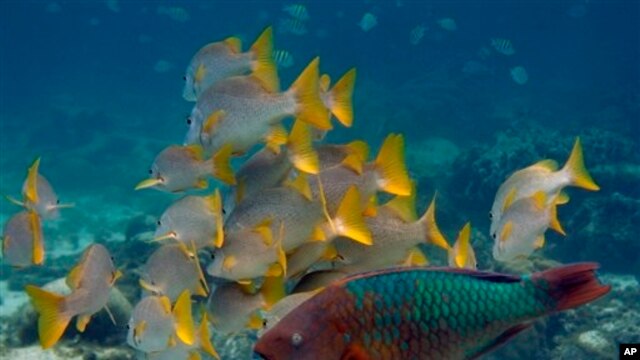
From VOA Learning English, this is Science in the News. I’m Katherine Cole.
And I’m Christopher Cruise. Today we tell about a United Nations report on the environment. It says 2013 may have been one of the 10 warmest years since modern recordkeeping began. Then, we hear how levels of heat-trapping gases in Earth’s atmosphere set a record in 2012. We also tell about a call by the World Bank to reduce some pollutants. The bank says the reduction could slow the rate of climate change, and save lives.
Scientists say last year was among the hottest years ever on planet Earth. A United Nations report says 2013 was probably one of the 10 warmest years since 1850. That was the year when scientists began collecting temperature records.
The report was released in November at the UN climate change conference in Warsaw, Poland. Scientists at the World Meteorological Organization produced the report. It shows temperatures in different areas of the world. It also provides information about rainfall, floods, extreme dry weather, tropical cyclones, ice cover and sea level.
Michel Jarraud is Secretary-General of the World Meteorological Organization, the WMO. He says records show the Earth is warmer now than it was 10 years ago.
“This decade, the last decade was the warmest decade on record and what we call cold years now are actually warmer than any warm year before ’98.”
He also says levels of carbon dioxide and other greenhouse gases reached new highs in 2012. Greenhouse gases trap heat in the atmosphere. He believes that, as more heat gets trapped, temperatures on Earth’s surface will continue rising.
The WMO report says surface temperatures are only part of the story. It says the water cycle of droughts, floods and heavy rains is also having an effect on the planet.

Michel Jarraud says higher sea levels are making people who live near oceans likely targets for storm surges. This happened recently when a powerful storm, Typhoon Haiyan, struck the Philippines.
“Near Philippines, the sea level rise over the last 20 years was probably of the order of three to four times bigger than it was globally. The factor on the sea level rise itself can be attributed to a large extent to the climate change, which has occurred. So, in other words, the cyclone itself it is a difficult question, but definitely because of the higher sea level the damage has been more than what it would have been 100 years before under similar wind condition.”
The report says most of the world’s land areas had temperatures higher than normal in the first nine months of 2013. Australia had a very strong heat wave. Record high temperatures were also reported in parts of North America, northeastern South America, northern Africa, and much of Eurasia.
The report says record-breaking rainfall and snow fell in many parts of North America. At the same time, extremely dry weather was a problem in the southern African countries of Angola and Namibia. People there experienced one of the worst droughts in the past 30 years.
Some studies have found that a warmer atmosphere makes bad weather worse. Yet no single weather event can be linked to climate change. Richard Kerr is a writer for Science magazine.
“Beyond heat waves and heavy precipitation, heavy rain storms, heavy snow storms, scientists are being much more cautious about making a connection between typhoons or tornadoes and global warming.”
As we noted earlier, the amount of greenhouse gases in Earth’s atmosphere reached a record high in 2012. The World Meteorological Organization says this will have an effect on climate change unless countries do more to limit the gases.
The WMO says the warming effect on the Earth’s climate has risen by nearly one-third since 1990. It says the rise is mainly a result of carbon dioxide and other heat-trapping gases, like methane and nitrous oxide.
The UN agency’s Greenhouse Gas Bulletin blames fossil fuel-linked emissions -- mostly from carbon dioxide -- for about 80 percent of the increase in warming. It says carbon dioxide in the atmosphere grew faster in 2012 than the average growth rate over the past 10 years.
WMO Secretary-General Michel Jarraud blames the increase in carbon dioxide levels on human activity, including industry, energy production and land use.
“CO2 is a very stable gas, so it means that there is no sort of chemical reaction which would destroy naturally the CO2 from the atmosphere. So it stays for very long periods -- hundreds of years, or even more. And that is why, as a consequence, the actions we take now or the actions we do not take now will have consequences for a very, very long period.”
The WMO says methane is the second biggest contributor to greenhouse gas and to the possible warming of the atmosphere. About 40 percent of methane comes from natural sources, such as wetlands and termites. The rest comes from human activities.
Nitrous oxide is the third most important greenhouse gas. The WMO says about 60 percent of nitrous oxide comes from natural sources. The rest is from human activities.
Recently, the Intergovernmental Panel on Climate Change reported that levels of carbon dioxide, methane and nitrous oxide are all breaking records. The report said the gas levels are now higher than they have been for over 800,000 years.
Michel Jarraud says this is causing Earth’s climate to change in worrisome ways.
“We are worried not only about the impact on temperature, which is important, but also the impact on the water cycle -- more droughts, more floods in other parts of the world. We are worried about the impact on a number of extreme weather events. We are worried about the impact on the sea the level.”
Mr. Jarraud says average temperatures may be 4.6 degrees higher than pre-industrial levels by the end of this century if the world carries on with what he calls “business as usual.” He says this would have harmful effects for future generations.
He says even if all nations act now and stop producing carbon dioxide immediately, the effects of the climate change will be felt for centuries.
A World Bank report is calling for action on a treaty to replace the Kyoto Protocol, the climate agreement that was in effect through the end of 2012. The report says Typhoon Haiyan is evidence that global warming is real.
The storm was one of the deadliest natural disasters in the Philippines. It left nearly 6,000 people dead and more than four million others homeless. Rachel Kyte is the Vice President for Sustainable Development at the World Bank.
“This is not going to be a one off (one of a kind) event. The intensity and frequency of storms as a result of climate change is very clear from the climate science and the evidence and is something that many countries will have to prepare for.”
The World Bank report examines the cryosphere, places on the planet that stay below zero degrees Celsius. It says temperatures in places like Antarctica and the Himalaya Mountains are rising two times as fast as in other areas.
“We’re seeing catastrophic change potentially in these regions. If the ice of the Himalayas disappears, there are billions of people who depend on that ice cap for water and for livelihoods.”
Many scientists are worried about carbon dioxide, which stays in the atmosphere for centuries. But the report calls for reducing pollutants that do not last as long. It says methane, for example, disappears after about 12 years. Black carbon or soot from open-fire cook stoves stays in the air for just days or weeks.
Rachel Kyte says these pollutants speed up warming. She says acting quickly to reduce them can lessen their effect on the planet and save lives.
“Six million people today die every year from outdoor and indoor air pollution. So if we were to change cooking methods, if we were to clean up emissions from old cars and from diesel engines, we could save six million lives and we could slow the rate at which climate change is coming.”
Those actions and others can give nations the time they need to make changes.
Many scientists agree that by 2020, our planet will be about two degrees Celsius warmer than it was before the industrial revolution. That means there could be more severe weather and rising seas.
Rachel Kyte says that is something that climate negotiators should understand. She is happy that a growing number of nations, including the United States, are trying to reduce short-term pollutants.
“And those governments coming together with institutions like ourselves, the United Nations Environment Program, the International Cryosphere Association, but then also with civil society and the private sector saying, ‘We don’t have to wait for an international agreement on greenhouse gas emissions. We can take action now on black carbon. We can take action now on methane, and we can have a measurable impact in a very short period of time.’”
Elliot Diringer is a policy expert at the Center for Climate and Energy Solutions. He says the Warsaw climate change conference did little to develop a new plan to reduce global emissions like carbon dioxide. But he thinks it provided a clue about what a new treaty might look like. He thinks the agreement will be one created by national politics, and less by decisions made by international negotiations.
“Instead, this time countries will be setting their own numbers. And I think this is an important recognition that, in fact, the effort needs to come from the bottom up, that the agreement has to reflect the political will that is being generated at the national level, as well as the policies that are taking shape at the national level.”
He also notes some hopeful signs: emissions trading efforts in China, the new climate law in Mexico and the Climate Action Plan announced by President Barack Obama last year.
This Science in the News was based on reports from Lisa Schlein in Geneva and Rosanne Skirble in Washington. It was written by Christopher Cruise and produced by June Simms. I’m Katherine Cole.
And I’m Christopher Cruise. Join us next week for more news about science on the Voice of America.



